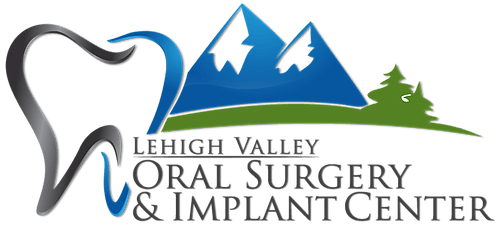Cuspid Exposure: A Gentle Guide to a Common Procedure
Are impacted canines keeping your smile hidden? Lehigh Valley Oral Surgery and Implant Center in Bethlehem, PA can help. Our experienced oral surgeons in Lehigh Valley specialize in cuspid exposure, a procedure that gently brings impacted canines into proper alignment.
Don’t let crooked teeth or jaw pain hold you back. Call us today at 484-821-1357 to schedule a consultation and discover the smile you deserve.
Understanding Cuspid Exposure
Cuspid exposure, also known as canine exposure or canine eruption assistance, is a surgical procedure that helps to bring impacted canines (also known as “eye teeth”) into proper alignment. Impacted canines are teeth that are unable to erupt normally due to lack of space or other underlying issues. If a baby tooth is present, it will be removed during the procedure to ensure proper alignment.
Patients frequently develop problems with impacted teeth, particularly third molars, which can lead to painful infections and other complications.
Causes and Symptoms of Impacted Canine Teeth
Impacted canine teeth can arise from various factors, such as dental crowding, baby teeth that don’t fall out on time, or growths obstructing the tooth’s path. Recognizing the symptoms of impacted canine teeth is crucial for timely intervention. Common signs include severe pain or discomfort in the gum or jaw, swelling or redness in the gum or face, and difficulty biting or chewing. You might also notice visible gaps or unevenness in your teeth, or adjacent teeth that appear crowded or overlapping.
If left untreated, impacted canine teeth can lead to more serious issues, such as infections, cysts, or damage to surrounding teeth. Addressing these symptoms early with the help of an oral surgeon can prevent further complications and ensure a healthier smile.
 Why Is Cuspid Exposure Necessary?
Why Is Cuspid Exposure Necessary?
If a canine tooth remains impacted, it can cause several problems, including:
- Crowding: Impacted canines can push other teeth out of alignment, leading to crowding and crooked teeth.
- Gum Disease: Impacted teeth can be difficult to clean, increasing the risk of gum disease.
- Cysts: In some cases, impacted canines can lead to the formation of cysts around the tooth.
- Jaw Pain: Impacted canines can cause pain and discomfort in the jaw.
Maxillary canines are commonly impacted and require early intervention to prevent complications.
Benefits of Cuspid Exposure Surgery
Cuspid exposure surgery, also known as impacted canine exposure, is a relatively minor surgical procedure that offers significant benefits. One of the primary advantages is relief from the pain and discomfort caused by impacted canine teeth. Additionally, the surgery can improve your overall oral health by reducing the risk of infections and other complications.
Beyond health benefits, cuspid exposure surgery can enhance the appearance and alignment of your teeth, boosting your confidence and self-esteem. By preventing more serious problems, such as cysts or damage to surrounding teeth, this procedure ensures long-term dental health and a more beautiful smile.
The Cuspid Exposure Procedure
Cuspid exposure is a surgical procedure that helps to bring impacted canine teeth (also known as “eye teeth”) into proper alignment. Impacted canines are teeth that are unable to erupt normally due to lack of space or other underlying issues.
- Anesthesia: The procedure is typically performed under local anesthesia and dental sedation, which numbs the area around the impacted tooth.
- Incision: The oral surgeon makes a small incision in the gum tissue over the impacted canine.
- Bone Removal: If necessary, the surgeon removes any overlying bone that is preventing the tooth from erupting. The gum is lifted to reveal the hidden tooth underneath.
- Exposure: The impacted canine is exposed and a small wire or bracket is attached to it. The exposed tooth is the focus for bonding an orthodontic attachment.
- Closure: The incision is then closed with sutures.
The expose and bond procedure involves collaboration between an oral surgeon and an orthodontist to ensure proper alignment of the tooth, addressing issues such as dental crowding or obstructed growth that may prevent the canine from falling into place.
Recovery from Cuspid Exposure
Recovery from cuspid exposure is typically quick and painless. Patients can usually return to their normal activities within a few days. However, there may be some swelling and discomfort for the first few days.

- Follow post-operative instructions: Be sure to follow your oral surgeon’s instructions carefully, including taking any prescribed medications.
- Avoid strenuous activity: Avoid strenuous physical activity for the first few days.
- Maintain good oral hygiene: Brush and floss your teeth gently to keep the area clean.
- Use a cold compress: Apply a cold compress to your jaw to help reduce swelling.
- Avoid hot foods and drinks: Hot foods and drinks can irritate the area.
If you experience any unusual symptoms or concerns, contact your oral surgeon immediately.
Relationship with Wisdom Teeth
Impacted canine teeth are often compared to impacted wisdom teeth due to their similar potential for causing problems and requiring treatment. However, impacted canine teeth are more common and can significantly affect the overall health and appearance of your dental arch. While wisdom teeth are frequently removed when impacted, impacted canine teeth are typically treated with exposure surgery to help them erupt into the correct position.
Understanding this distinction helps in appreciating the unique approach required for each type of impacted tooth, ensuring health and aesthetic concerns are addressed effectively.
Choosing the Right Oral Surgeon for Cuspid Exposure
Selecting the right oral surgeon is crucial for a successful cuspid exposure procedure. When choosing an oral surgeon, be sure to consider the following factors:
- Experience: Look for an oral surgeon who has extensive experience in performing cuspid exposure procedures.
- Credentials: Make sure the oral surgeon is board-certified and has the necessary training and qualifications.
- Facilities: The oral surgeon’s office or clinic should have modern facilities and state-of-the-art equipment.
- Compassion: The oral surgeon should be compassionate and understanding of your needs and concerns.
Orthodontic Treatment and Cuspid Exposure
Orthodontic treatment often plays a crucial role alongside cuspid exposure surgery to guide the impacted canine tooth into its correct position. This may involve braces or other orthodontic appliances to ensure the tooth moves properly within the dental arch. The collaboration between your oral surgeon and orthodontist is essential in developing a comprehensive treatment plan that addresses the impacted canine tooth and any other orthodontic needs.
This integrated approach ensures that the impacted canine tooth is not only exposed but also aligned correctly, contributing to a healthier and more aesthetically pleasing smile.
Cost and Insurance
The cost of cuspid exposure surgery can vary based on the complexity of the procedure and the location of the impacted tooth. Many dental insurance plans cover at least part of the cost, but coverage can differ. It’s important to consult with your oral surgeon and orthodontist to determine the best course of treatment and discuss the associated costs and insurance options.
Understanding the financial aspects of the procedure helps in planning and ensuring that you receive the necessary care without undue financial stress. Your oral surgeon’s office can assist in navigating insurance claims and payment plans to make the process as smooth as possible.
Frequently Asked Questions
Is cuspid exposure painful?
Cuspid exposure is typically performed under local anesthesia, so you should not feel any pain during the procedure. However, there may be some discomfort or swelling after the procedure.
How long does recovery from cuspid exposure take?
Recovery from cuspid exposure is typically quick and painless. Most patients can return to their normal activities within a few days.
Can impacted canine teeth cause other problems?
If left untreated, impacted canines can cause several problems, including crowding, gum disease, cysts, and jaw pain.
What are the risks of cuspid exposure?
The risks of cuspid exposure are minimal. However, there is a small risk of infection, bleeding, or nerve damage.
Schedule Your Consultation Today
Lehigh Valley Oral Surgery and Implant Center in Bethlehem, PA is an excellent choice for cuspid exposure procedures. Our experienced oral surgeons are committed to providing the highest quality care in a comfortable and welcoming environment. We serve patients from throughout the Lehigh Valley, including Stroudsburg, PA.
Call us today at 484-821-1357 to schedule a consultation.
Start your new smile journey today!

 Why Is Cuspid Exposure Necessary?
Why Is Cuspid Exposure Necessary?
